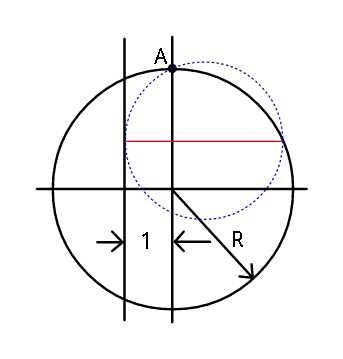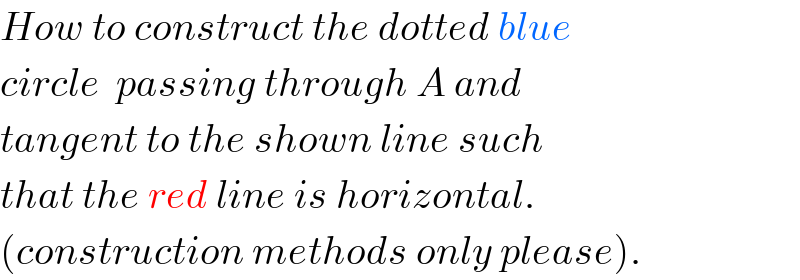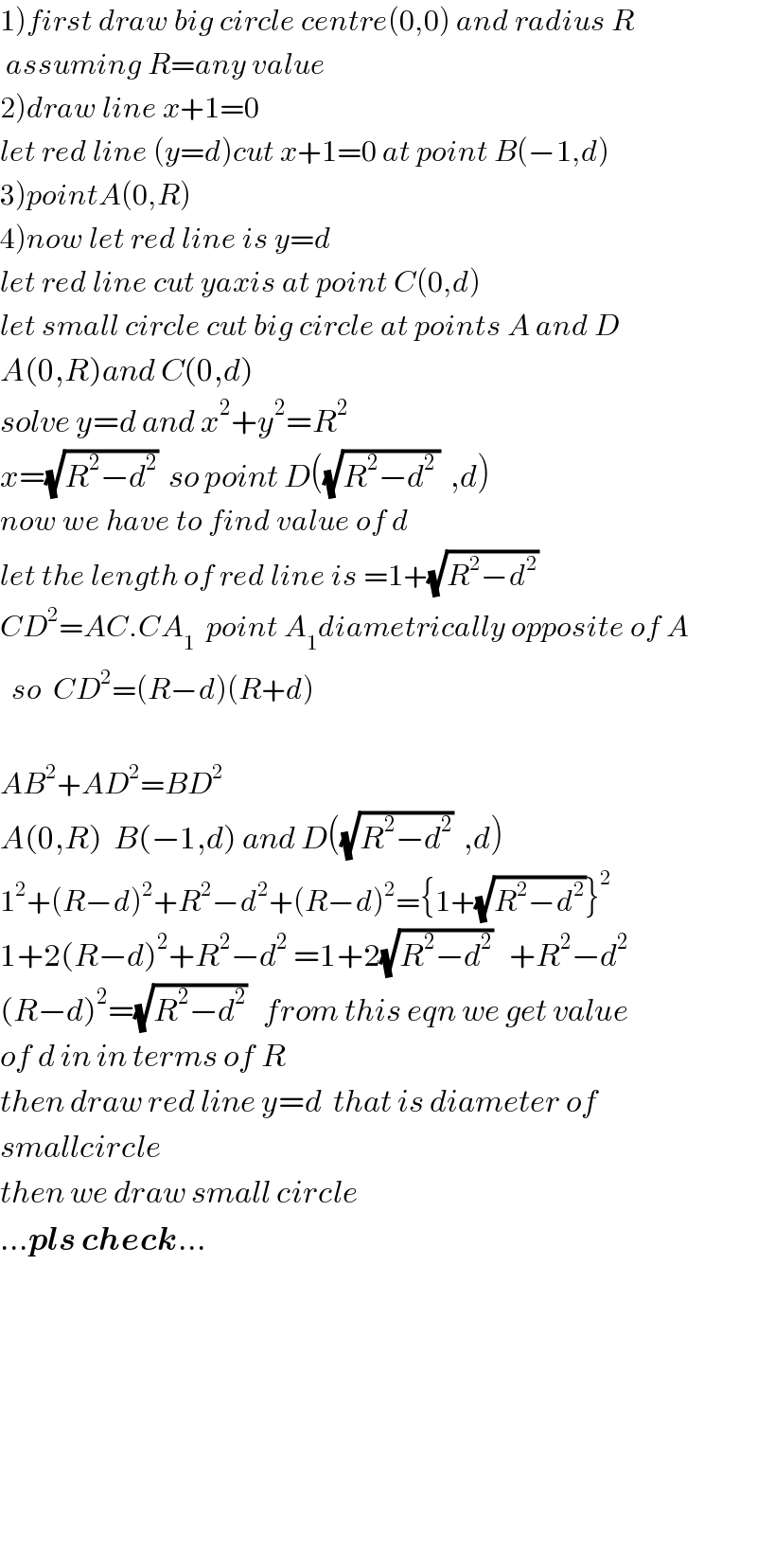Question Number 41324 by ajfour last updated on 05/Aug/18

Commented by ajfour last updated on 05/Aug/18

$${How}\:{to}\:{construct}\:{the}\:{dotted}\:{blue} \\ $$$${circle}\:\:{passing}\:{through}\:{A}\:{and} \\ $$$${tangent}\:{to}\:{the}\:{shown}\:{line}\:{such} \\ $$$${that}\:{the}\:{red}\:{line}\:{is}\:{horizontal}. \\ $$$$\left({construction}\:{methods}\:{only}\:{please}\right). \\ $$
Commented by MJS last updated on 06/Aug/18

$${A}=\begin{pmatrix}{\mathrm{0}}\\{{R}}\end{pmatrix}\:\:{M}=\begin{pmatrix}{{r}−\mathrm{1}}\\{{y}}\end{pmatrix}\:\:{B}=\begin{pmatrix}{\mathrm{2}{r}−\mathrm{1}}\\{{y}}\end{pmatrix} \\ $$$$\mid{OB}\mid^{\mathrm{2}} −{R}^{\mathrm{2}} =\mathrm{0} \\ $$$$\mid{MA}\mid^{\mathrm{2}} −{r}^{\mathrm{2}} =\mathrm{0} \\ $$$$\left(\mathrm{2}{r}−\mathrm{1}\right)^{\mathrm{2}} +{y}^{\mathrm{2}} −{R}^{\mathrm{2}} =\mathrm{0}\:\Rightarrow\:{y}^{\mathrm{2}} =−\mathrm{4}{r}^{\mathrm{2}} +\mathrm{4}{r}+{R}^{\mathrm{2}} −\mathrm{1} \\ $$$$\left({r}−\mathrm{1}\right)^{\mathrm{2}} +\left({y}−{R}\right)^{\mathrm{2}} −{r}^{\mathrm{2}} =\mathrm{0}\:\Rightarrow\:{y}^{\mathrm{2}} =\mathrm{2}{r}+\mathrm{2}{Ry}−{R}^{\mathrm{2}} −\mathrm{1} \\ $$$$−\mathrm{4}{r}^{\mathrm{2}} +\mathrm{4}{r}+{R}^{\mathrm{2}} −\mathrm{1}=\mathrm{2}{r}+\mathrm{2}{Ry}−{R}^{\mathrm{2}} −\mathrm{1} \\ $$$${y}=\frac{−\mathrm{2}{r}^{\mathrm{2}} +{r}+{R}^{\mathrm{2}} }{{R}} \\ $$$$\left(\frac{−\mathrm{2}{r}^{\mathrm{2}} +{r}+{R}^{\mathrm{2}} }{{R}}\right)^{\mathrm{2}} =−\mathrm{4}{r}^{\mathrm{2}} +\mathrm{4}{r}+{R}^{\mathrm{2}} −\mathrm{1} \\ $$$${r}^{\mathrm{4}} −{r}^{\mathrm{3}} +\frac{\mathrm{1}}{\mathrm{4}}{r}^{\mathrm{2}} −\frac{{R}^{\mathrm{2}} }{\mathrm{2}}{r}+\frac{{R}^{\mathrm{2}} }{\mathrm{4}}=\mathrm{0} \\ $$$$\left({r}−\frac{\mathrm{1}}{\mathrm{2}}\right)\left({r}^{\mathrm{3}} −\frac{\mathrm{1}}{\mathrm{2}}{r}^{\mathrm{2}} −\frac{{R}^{\mathrm{2}} }{\mathrm{2}}\right)=\mathrm{0} \\ $$$$\:\:\:\:\:\left({r}=\frac{\mathrm{1}}{\mathrm{2}}\:\Rightarrow\:{y}={R};\:{M}=\begin{pmatrix}{−\frac{\mathrm{1}}{\mathrm{2}}}\\{{R}}\end{pmatrix}\:\:{B}={A}\right) \\ $$$${r}^{\mathrm{3}} −\frac{\mathrm{1}}{\mathrm{2}}{r}^{\mathrm{2}} −\frac{{R}^{\mathrm{2}} }{\mathrm{2}}=\mathrm{0} \\ $$$${r}={z}+\frac{\mathrm{1}}{\mathrm{6}} \\ $$$${z}^{\mathrm{3}} −\frac{\mathrm{1}}{\mathrm{12}}{z}−\left(\frac{{R}^{\mathrm{2}} }{\mathrm{2}}+\frac{\mathrm{1}}{\mathrm{108}}\right)=\mathrm{0} \\ $$$${z}=\frac{\mathrm{1}}{\mathrm{6}}\left(\sqrt[{\mathrm{3}}]{\mathrm{54}{R}^{\mathrm{2}} +\mathrm{1}+\sqrt{\mathrm{81}{R}^{\mathrm{2}} +\mathrm{3}}}+\sqrt[{\mathrm{3}}]{\mathrm{54}{R}^{\mathrm{2}} +\mathrm{1}−\sqrt{\mathrm{81}{R}^{\mathrm{2}} +\mathrm{3}}}\right) \\ $$$${r}=\frac{\mathrm{1}}{\mathrm{6}}\left(\mathrm{1}+\sqrt[{\mathrm{3}}]{\mathrm{54}{R}^{\mathrm{2}} +\mathrm{1}+\sqrt{\mathrm{81}{R}^{\mathrm{2}} +\mathrm{3}}}+\sqrt[{\mathrm{3}}]{\mathrm{54}{R}^{\mathrm{2}} +\mathrm{1}−\sqrt{\mathrm{81}{R}^{\mathrm{2}} +\mathrm{3}}}\right) \\ $$$$\mathrm{I}\:\mathrm{don}'\mathrm{t}\:\mathrm{think}\:\mathrm{we}\:\mathrm{can}\:\mathrm{construct}\:\mathrm{this}… \\ $$$$\mathrm{interestingly}\:{r}\in\mathbb{Q}\:\mathrm{for}\:\mathrm{some}\:\mathrm{values}\:\mathrm{of}\:{R}\in\mathbb{Q} \\ $$$$\mathrm{found}\:\mathrm{it}\:\mathrm{by}\:\mathrm{trying}\:{R}\in\mathbb{N} \\ $$$$\left({R}/{r}\right)= \\ $$$$=\left\{\left(\mathrm{0}/\frac{\mathrm{1}}{\mathrm{2}}\right),\:\left(\mathrm{1}/\frac{\mathrm{1}}{\mathrm{1}}\right),\:\left(\mathrm{5}/\frac{\mathrm{5}}{\mathrm{2}}\right),\:\left(\mathrm{15}/\frac{\mathrm{15}}{\mathrm{3}}\right),\:\left(\mathrm{34}/\frac{\mathrm{34}}{\mathrm{4}}\right),\:\left(\mathrm{65}/\frac{\mathrm{65}}{\mathrm{5}}\right),\:…\right\} \\ $$$$\mathrm{this}\:\mathrm{leads}\:\mathrm{to} \\ $$$${R}=\frac{\mathrm{1}}{\mathrm{2}}{n}^{\mathrm{3}} −\frac{\mathrm{3}}{\mathrm{2}}{n}^{\mathrm{2}} +\mathrm{2}{n}−\mathrm{1} \\ $$$${r}=\frac{\mathrm{1}}{\mathrm{2}}{n}^{\mathrm{2}} −{n}+\mathrm{1} \\ $$$${y}=\frac{\mathrm{1}}{\mathrm{2}}{n}^{\mathrm{3}} −\frac{\mathrm{3}}{\mathrm{2}}{n}+{n} \\ $$$$\Rightarrow\:{n}\in\mathbb{Q}\:\Rightarrow\:{R},\:{r},\:{y}\:\in\mathbb{Q} \\ $$
Answered by tanmay.chaudhury50@gmail.com last updated on 06/Aug/18

$$\left.\mathrm{1}\right){first}\:{draw}\:{big}\:{circle}\:{centre}\left(\mathrm{0},\mathrm{0}\right)\:{and}\:{radius}\:{R} \\ $$$$\:{assuming}\:{R}={any}\:{value} \\ $$$$\left.\mathrm{2}\right){draw}\:{line}\:{x}+\mathrm{1}=\mathrm{0} \\ $$$${let}\:{red}\:{line}\:\left({y}={d}\right){cut}\:{x}+\mathrm{1}=\mathrm{0}\:{at}\:{point}\:{B}\left(−\mathrm{1},{d}\right) \\ $$$$\left.\mathrm{3}\right){pointA}\left(\mathrm{0},{R}\right) \\ $$$$\left.\mathrm{4}\right){now}\:{let}\:{red}\:{line}\:{is}\:{y}={d} \\ $$$${let}\:{red}\:{line}\:{cut}\:{yaxis}\:{at}\:{point}\:{C}\left(\mathrm{0},{d}\right) \\ $$$${let}\:{small}\:{circle}\:{cut}\:{big}\:{circle}\:{at}\:{points}\:{A}\:{and}\:{D} \\ $$$${A}\left(\mathrm{0},{R}\right){and}\:{C}\left(\mathrm{0},{d}\right) \\ $$$${solve}\:{y}={d}\:{and}\:{x}^{\mathrm{2}} +{y}^{\mathrm{2}} ={R}^{\mathrm{2}} \\ $$$${x}=\sqrt{{R}^{\mathrm{2}} −{d}^{\mathrm{2}} }\:\:{so}\:{point}\:{D}\left(\sqrt{{R}^{\mathrm{2}} −{d}^{\mathrm{2}\:} }\:\:,{d}\right) \\ $$$${now}\:{we}\:{have}\:{to}\:{find}\:{value}\:{of}\:{d} \\ $$$${let}\:{the}\:{length}\:{of}\:{red}\:{line}\:{is}\:=\mathrm{1}+\sqrt{{R}^{\mathrm{2}} −{d}^{\mathrm{2}} }\:\: \\ $$$${CD}^{\mathrm{2}} ={AC}.{CA}_{\mathrm{1}} \:\:{point}\:{A}_{\mathrm{1}} {diametrically}\:{opposite}\:{of}\:{A} \\ $$$$\:\:{so}\:\:{CD}^{\mathrm{2}} =\left({R}−{d}\right)\left({R}+{d}\right) \\ $$$$ \\ $$$${AB}^{\mathrm{2}} +{AD}^{\mathrm{2}} ={BD}^{\mathrm{2}} \\ $$$${A}\left(\mathrm{0},{R}\right)\:\:{B}\left(−\mathrm{1},{d}\right)\:{and}\:{D}\left(\sqrt{{R}^{\mathrm{2}} −{d}^{\mathrm{2}} }\:\:,{d}\right) \\ $$$$\mathrm{1}^{\mathrm{2}} +\left({R}−{d}\right)^{\mathrm{2}} +{R}^{\mathrm{2}} −{d}^{\mathrm{2}} +\left({R}−{d}\right)^{\mathrm{2}} =\left\{\mathrm{1}+\sqrt{{R}^{\mathrm{2}} −{d}^{\mathrm{2}} }\right\}^{\mathrm{2}} \\ $$$$\mathrm{1}+\mathrm{2}\left({R}−{d}\right)^{\mathrm{2}} +{R}^{\mathrm{2}} −{d}^{\mathrm{2}} \:=\mathrm{1}+\mathrm{2}\sqrt{{R}^{\mathrm{2}} −{d}^{\mathrm{2}} }\:\:\:+{R}^{\mathrm{2}} −{d}^{\mathrm{2}} \\ $$$$\left({R}−{d}\right)^{\mathrm{2}} =\sqrt{{R}^{\mathrm{2}} −{d}^{\mathrm{2}} }\:\:\:{from}\:{this}\:{eqn}\:{we}\:{get}\:{value} \\ $$$${of}\:{d}\:{in}\:{in}\:{terms}\:{of}\:{R} \\ $$$${then}\:{draw}\:{red}\:{line}\:{y}={d}\:\:{that}\:{is}\:{diameter}\:{of} \\ $$$${smallcircle}\: \\ $$$${then}\:{we}\:{draw}\:{small}\:{circle} \\ $$$$…\boldsymbol{{pls}}\:\boldsymbol{{check}}… \\ $$$$ \\ $$$$ \\ $$$$ \\ $$$$ \\ $$$$ \\ $$$$ \\ $$$$ \\ $$
Commented by ajfour last updated on 06/Aug/18

$${Thank}\:{you}\:{both},\:{Tanmay}\:{Sir}\:\& \\ $$$${MjS}\:{Sir}.\:{I}\:{thought}\:{we}\:{can} \\ $$$${construct};\:{may}\:{be}. \\ $$
